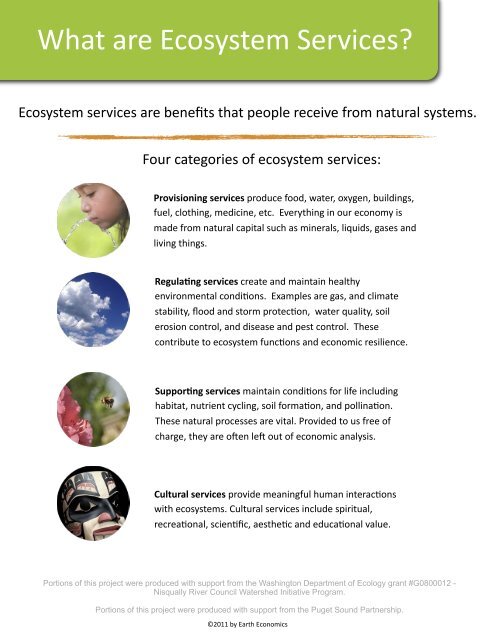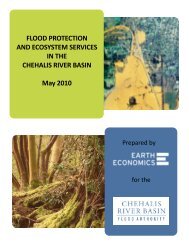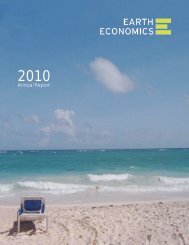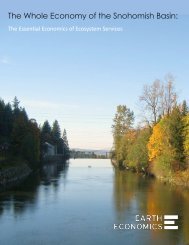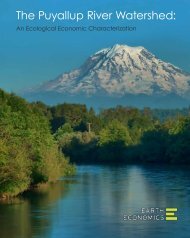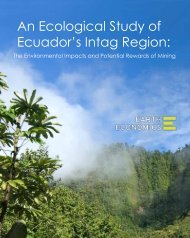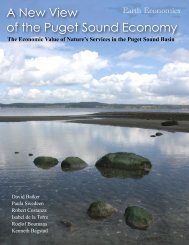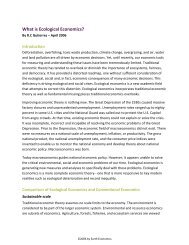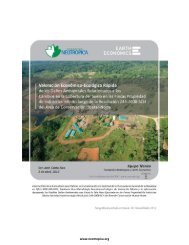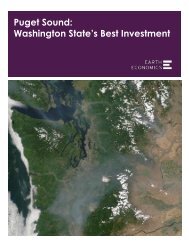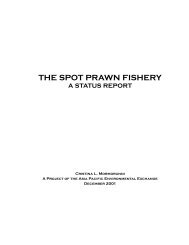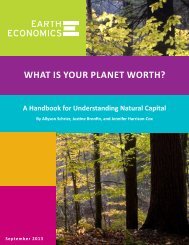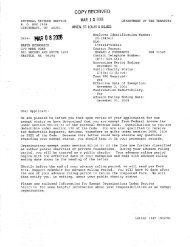What are Ecosystem Services? - Earth Economics
What are Ecosystem Services? - Earth Economics
What are Ecosystem Services? - Earth Economics
You also want an ePaper? Increase the reach of your titles
YUMPU automatically turns print PDFs into web optimized ePapers that Google loves.
<strong>What</strong> <strong>are</strong> <strong>Ecosystem</strong> <strong>Services</strong><br />
<strong>Ecosystem</strong> services <strong>are</strong> benefits that people receive from natural systems.<br />
Four categories of ecosystem services:<br />
Provisioning services produce food, water, oxygen, buildings,<br />
fuel, clothing, medicine, etc. Everything in our economy is<br />
made from natural capital such as minerals, liquids, gases and<br />
living things.<br />
Regula0ng services create and maintain healthy<br />
environmental condions. Examples <strong>are</strong> gas, and climate<br />
stability, flood and storm protecon, water quality, soil<br />
erosion control, and disease and pest control. These<br />
contribute to ecosystem funcons and economic resilience.<br />
Suppor0ng services maintain condions for life including<br />
habitat, nutrient cycling, soil formaon, and pollinaon.<br />
These natural processes <strong>are</strong> vital. Provided to us free of<br />
charge, they <strong>are</strong> oCen leC out of economic analysis.<br />
Cultural services provide meaningful human interacons<br />
with ecosystems. Cultural services include spiritual,<br />
recreaonal, scienfic, aesthec and educaonal value.<br />
Portions of this project were produced with support from the Washington Department of Ecology grant #G0800012 -<br />
Nisqually River Council Watershed Initiative Program.<br />
Portions of this project were produced with support from the Puget Sound Partnership.<br />
©2011 by <strong>Earth</strong> <strong>Economics</strong>
Resiliency is the ability of a system to withstand and recover<br />
from disturbances such as polluon or natural disasters.<br />
<strong>Ecosystem</strong>s (forests or wetlands) <strong>are</strong> self‐maintaining and<br />
remarkably resilient comp<strong>are</strong>d with built capital (car or levee).<br />
Regulang services, such as water quality and climate<br />
regulaon, create ecosystem resiliency by allowing it to connue<br />
in a sustainable manner.<br />
Goods and <strong>Services</strong><br />
Goods <strong>are</strong> things “you can drop on your toe.” Goods can be measured by quanty, such as<br />
pounds of fish or gallons of water. <strong>Services</strong> <strong>are</strong> benefits you cannot “drop on your toe.” Such as<br />
flood protecon or water quality. Goods can be valued with a price/quanty.<br />
<strong>Services</strong> require different measures other than physical quanty produced. For example, labor,<br />
water quality, or recreaon.<br />
<strong>Ecosystem</strong> services<br />
<strong>Ecosystem</strong> services require “natural capital”, such as a forest or marine ecosystem, with<br />
physical and/or nonphysical processes to support human acvies and sustain life. For<br />
example, forest and soils <strong>are</strong> natural capital assets that provide the ecosystem service of<br />
filtering water without need of a costly filtraon plant.<br />
A threshold is a point at which a system may<br />
experience a dramac change or collapse. Thresholds<br />
may include heavy rainfall triggering landslides and<br />
floods, loss of habitat causing species exncon or<br />
dramac climate change.<br />
©2011 by <strong>Earth</strong> <strong>Economics</strong>


